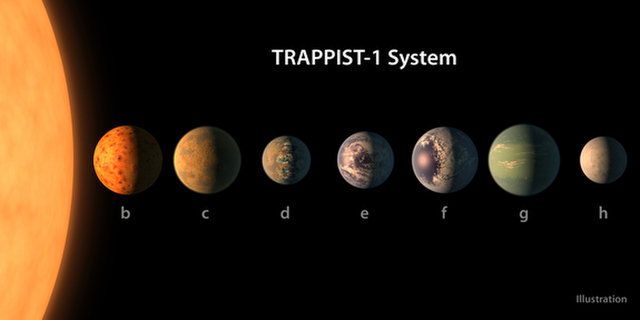An Alien Solar System: TRAPPIST-1 Discovery Tops Our 2017 Exoplanet List
The year 2017 featured one of the most remarkable exoplanet discoveries in recent memory: a total of seven Earth-size planets have been found orbiting a cool dwarf star, three planets of which are in "goldilocks" orbits, meaning they could have conditions right for life.
In Feb. 2017, the scientific journal Nature published a paper detailing the new exoplanet findings, by lead author Michaël Gillon, a scientist from the Institute of Astrophysics at the University of Liège in Belgium. Initial observations hinted at the existence of several tightly packed planets orbiting the ultracool star now known as TRAPPIST-1, with three planets confirmed. Using two telescopes located on opposite sides of the world, and one in space, Gillon and his team then found four more rocky planets in the TRAPPIST-1 system at the start of this year, bringing the grand total to seven. Researchers can't yet discern surface features on those planets, but the discovery kindled excitement about the search for life elsewhere in the universe. [The Most Intriguing Exoplanet Discoveries of 2017]
"I'm fascinated by the possible existence of life elsewhere," Gillon said in an interview with Space.com. As principal investigator of the exoplanet discoveries of TRAPPIST-1, he said he is excited by the results, but still finds the studies challenging to contextualize.
Gillon said he is motivated by the discovery, but noted it is still too early to tell how frequently these types of systems (with multiple rocky planets) develop in the universe. But scientists are looking forward to what this work means for the future of astronomy.
"We are expanding the sample of terrestrial planets we can study … and soon we hope to have several dozens of planets that we will be able to really study," Gillon said. "So of course, we're superexcited."
When he began a 2011 prototype for a project known as the Search for habitable Planets EClipsing ULtra-cOOl Stars —whose acronym SPECULOOS spells out the name of a popular cookie flavor in his native Belgium —Gillon set out to observe 50 nearby small stars, and at about the 30th target, he discovered the first rocky body transiting, or passing in front of, TRAPPIST-1. [Major Discovery! 7 Earth-Size Alien Planets Circle Nearby Star]
"In 2015, in our data we saw one transit, two transit, three, and then a bunch of transits, and so we intensified our observation of this star and we used more telescopes … and we published our first results in 2016," Gillon said. "And then in 2017, we had much more data, especially thanks to the Spitzer Space Telescope. We had a complete sense of the system with these seven planets."
Breaking space news, the latest updates on rocket launches, skywatching events and more!
Located 39 light-years from Earth, the star TRAPPIST-1 is about the size of Jupiter. Its seven known planets travel around the star in tight orbits, and the closest planet, TRAPPIST-1b, completes one orbit (a "year") in just 1.51 Earth days. It was the first planet discovered in the system.
Initial observations came from the TRAnsiting Planets and Planeteslmals Small Telescope (TRAPPIST) in Chile. But, Gillon saw that confirming the first planet's orbit would require observing it from the other side of the world, too. TRAPPIST-1b completes an orbit in a day and a half, so to spot the next moment the planet completed an orbit, they'd need a confirmation from Asia. If a transit were visible at night in South America, a day and a half later would be daytime in the Americas. Gillon therefore used the Himalayan Chandra Telescope in India to confirm his findings. [Exoplanet Tour: Meet the 7 Earth-Size Planets of TRAPPIST-1]
All seven of the TRAPPIST-1 planets, including the three potentially habitable planets, are tidally locked to TRAPPIST-1, meaning one side of the planet always faces the star. (For example, the moon is tidally locked to Earth.) If a celestial body has a side that always faces the parent star, it may affect its ability to support life.
Researchers are already thinking about ways to find answers about the atmospheres of the TRAPPIST-1 planets.
Sara Seager, an astrophysicist and planetary scientist at the Massachusetts Institute of Technology (MIT), is the deputy director on the NASA mission, Transiting Exoplanet Survey Satellite (TESS). The spacecraft will scan the entire sky for two years, looking for transiting exoplanets. It is set to launch in the spring of 2018.
In an interview with Space.com, Seager shared that the TRAPPIST-1 discoveries "fortified" the TESS team's direction of research. Seager added that the TRAPPIST-1 discoveries are "just incredible" and supports the notion that when it comes to exoplanet systems, "almost anything is possible."
Follow Doris Elin Salazar on Twitter @salazar_elin. Follow us @Spacedotcom, Facebook and Google+. Original article on Space.com.

Doris is a science journalist and Space.com contributor. She received a B.A. in Sociology and Communications at Fordham University in New York City. Her first work was published in collaboration with London Mining Network, where her love of science writing was born. Her passion for astronomy started as a kid when she helped her sister build a model solar system in the Bronx. She got her first shot at astronomy writing as a Space.com editorial intern and continues to write about all things cosmic for the website. Doris has also written about microscopic plant life for Scientific American’s website and about whale calls for their print magazine. She has also written about ancient humans for Inverse, with stories ranging from how to recreate Pompeii’s cuisine to how to map the Polynesian expansion through genomics. She currently shares her home with two rabbits. Follow her on twitter at @salazar_elin.



